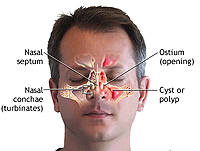Sinusitis is an inflammation of the sinuses and nasal passages. This type of health condition can be either chronic or acute depending on the predisposing factors. Sinusitis infection is a troublesome problem that changes the general health state of a person. Sinus infection symptoms are very similar to that of the common cold and viral influenza. Because of this, many people are not even aware that they are suffering from sinusitis until their condition has turned into chronic sinus infection.


Sinusitis is an inflammation of the sinuses and nasal passages. This type of health condition can be either chronic or acute depending on the predisposing factors.
Sinusitis infection is a troublesome problem that changes the general health state of a person.
Sinus infection symptoms are very similar to that of the common cold and viral influenza.
Because of this, many people are not even aware that they are suffering from sinusitis until their condition has turned into chronic sinus infection.
Sinus infection refers to the condition whereby the mucosal lining of the sinuses is inflamed. The sinuses are cavities and inside these cavities are mucosal linings.
The lining of the sinuses provides a very important and essential function in that they protect the body from dust, pollens, other foreign matter and pathogens in the air we breathe.
The surface of this lining is made up of soft membrane-like tissues, which is densely populated with microscopic hair-like cilia. The cilia act like oars to drain the mucus produced naturally by the body.
This mucus, together with trapped allergens and pathogens, are then flushed out to the stomach via the back of the throat. This is the way your body prevents bacteria load from building up within the nasal passages.
Healthy and proper cilia function is essential for optimum nasal health. When mucociliary function becomes dysfunctional, inflammation of the mucous membranes results and sinus obstruction caused by abnormal secretions of mucus within the sinus cavities lead to an increased pressure.
This then translates into pain and discomfort. What occurs actually is that the natural defense in the nose reacts to the bacteria or virus intrusion by forming extra mucus. If this extra mucus production cannot drain off efficiently, they tend to block the natural ventilation through the sinuses.
The result is an infection caused by these bacteria and virus proliferating in a condusive environment, and thus sinus infection.
Normally, the human body hosts bacteria like streptococcus and the like with no adverse effects. It is only when the body’s natural defenses are low that these pathogens get an upper hand.
People suffering from fungal infections, allergic reactions to certain types of food and drugs, related illnesses such as bronchitis, asthma and HIV, have higher chances of sinusitis recurrence.
Symptoms
Sinus infection symptoms include puffy eyes and early morning headaches in the frontal sinus region. Soreness and tenderness in the areas below the eye sockets are common.
Many will also feel discomfort and pain in the region between the eyes. Sinus pressure, sinus headache and sinus pain are commonly used terms to describe such discomfort.
Some people may be born with a predisposition towards sinus infection, whereas other people could develop it after an accident or surgery that changes the anatomy of the nose.
It is worth to mention that acute sinusitis usually lasts less than eight weeks or occurs no more than three times per year with each episode lasting no longer than 10 days.
Medications are usually effective against acute sinusitis. Successful treatment counteracts damage done to the mucous lining of the sinuses and surrounding bone of the skull.
Chronic sinusitis lasts longer than eight weeks or occurs more than four times per year with symptoms usually lasting more than 20 days.
Causes
Acute sinusitis usually follows a viral infection in the upper respiratory tract, but allergens or allergy causing substances or pollutants may also trigger acute sinusitis. A viral infection causes damage to the cells of the sinus lining.
This damage leads to inflammation. The lining thickens with fluid that obstructs the nasal passage. This passage connects to the sinuses.
The obstruction disrupts the process that removes bacteria normally present in the nasal passages, and the bacteria begin to multiply and invade the lining of the sinus. This causes sinus infection symptoms. Allergens and pollutants produce a similar effect.
Bacteria that normally cause acute sinusitis are streptococcus pneumoniae, haemophillus influenza and marroxella catarrhallis. These micro- organisms together with staphylococcus aureus and other anaerobes bacteria that live without (oxygen) are involved in chronic sinusitis.
Fungi are also becoming an increasing cause of chronic sinusitis, especially in people with diseases that weaken the immune system, such as AIDS, leukemia, and diabetes.
Precautions
Important to note is that the patient with this problem should not swim where the pools have much chlorine in them during a sinus infection.
Patient should not travel during an attack of sinusitis can be extremely uncomfortable and should be avoided if possible; otherwise Eustachian tube dysfunction could result.
One of the important precautions to take when one is suffering from sinusitis infection is to lead a temperate life breathing in clean, fresh air and daily cleansing of the sinus passages through nasal irrigation which is an all natural cure sinus infection remedy adopted by many people having this problem. This should effectively help in the control of recurring sinus infection.
Treatment
Options for mild cases of sinus infection include decongestants, pain killers and antibiotics. In chronic cases, doctors will prescribe anti-inflammatory drugs such as steroid nasal sprays together with oral corticosteroids.
For young children, the usage of steroids has to be monitored closely for it can inhibit their growth if taken for long periods. Surgery is undertaken as a last recourse.
Home remedies for sinus infection consist of inhalation of steam, saline nasal flushes and hot compresses placed on the forehead and facial region.
Ends


